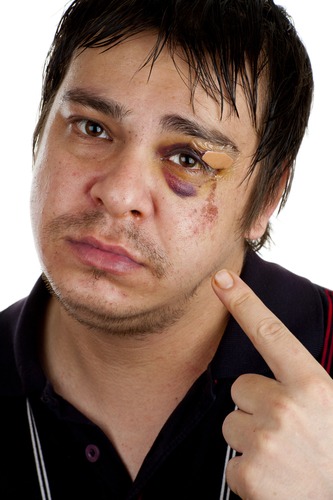What is a Black Eye?
Nearly every black eye comes with a story, and usually not a very fun one, since they're caused by a blunt force trauma to the eye. They are medically referred to as periorbital heamatoma, but your granddad would probably call it a shiner.
A black eye's dark appearance comes from the fluid build-up, usually blood, in the tissue surrounding the eye. The skin in that area of the face is very thin, and virtually transparent when stretched thin. As fluids build up, and cause the area to swell, they can be seen easily, giving a black eye its distinct appearance.
What Causes A Black Eye?
The cause of a black eye can be varied, but almost always involves some form of blunt trauma to the eye or nose. People get them in car accidents, while playing sports, from slipping and falling, and from physical violence. They can even occur as a result of severe sinus infections, and some medical operations, such as dental work or cosmetic surgery.
In very serious accidents, where the skull has become fractured, the internal bleeding that leads to a black eye can also lead to serious infections. If the bleeding occurs inside the eye itself, a condition called hyphema, emergency medical attention should be sought, as the increased pressure inside the eye can lead to permanent blindness.
Is A Black Eye Dangerous?

Black eyes aren't usually anything to worry about, and can be treated like any other type of bruise. However, since there is a risk that serious underlying damage may have occurred, it's always a good idea to have a doctor look at it and check for signs of other issues.
Below are list of signs or symptoms that should not be ignored, if any of the symptoms below are experienced with your black eye, you should seek medical advice
- Bleeding inside the eye (hyphema)
- Bleeding flow from the nose or ears
- Loss of balance or consciousness
- Blurry or double vision
- Loss of vision
- Appearance of flashes or floaters
- Difficulty moving the eye
- Intense pain
- Darkening around both eyes
- Headache lasting more than a few hours
- Warmth, redness, pus, fever, or any other signs of infection
- If you are taking blood thinners such as Warfarin
- If you are a Haemophiliac
How To Treat A Black Eye?
If there doesn't appear to be any reason to assume a more serious injury has occurred, a simple ice pack is the best way to soothe a black eye. Try to use a cold compress that can conform to the shape of the eye and face. A gel pack or package of frozen vegetables will do much better than a solid freezer pack or bag of ice cubes. In a pinch, a metal spoon chilled in ice water can be applied to the area, and re-chilled frequently. Never let the ice touch your skin or eye, wrap the ice in a clean dry cloth, only apply cold packs to the eye for 15 minutes at a time, resting for an hour in between each application. Regular over the counter drugs such as paracetamol or Ibuprofen should be enough to address the pain, but do not take Aspirin unless prescribed by a doctor as this can worsen the bruising.
How Long Does A Black Eye Last?
Healing time for a black eye is usually one to three weeks, depending on its severity. As a black eye heals it might change colours, showing shades of purple, green, blue, and yellow, this is caused by the different bodily fluids suspended under the skin as they slowly break down and are flushed away by the circulatory system.
What Can You Do To Get Rid Of A Black Eye?
Depending on how severe the black eye is will depend on how long it lasts, there is no way to speed up recovery time, a black eye is essentially a bruise (bleeding below the skin) and the only way it heals is for the body to break down the blood and reabsorb it, this can take between one and three weeks, you will notice the bruise changing colour from purple, to brown to green and yellow.
If you need to get rid of your black eye fast, maybe you have an interview about getting married, then the only effective way to get rid of a black eye is the application of make up - just be careful not to press too hard when blending in the foundation.
Author: John Dreyer Optometrist Bsc(Hons), MCOPTOM, DipCLP
Created: 12 Sep 2016, Last modified: 15 Feb 2024

